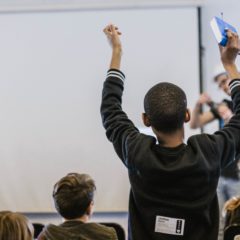
Students need to know what they are doing in your class every day. Since the start of my career, I have posted a daily agenda. It works! When a student asks what are they doing in class, I used to point to the board, and a student could read four to five steps listed for that period. After a suggestion from a principal, I began posting the learning target next to the agenda. Now an agenda and learning targets are part of my daily routines. It keeps me on target, and students know what they must demonstrate before leaving class, rather it is using a writing prompt, a worksheet, or an exit slip.
How I Set the Stage
My district has opted for a nine-week virtual learning model, yet I am still held to teaching the learning standards. We use Zoom to teach classes through our desktop computers. At the beginning of each class, I share my screen with the students. I show them the learning target first (click here to view roadmaps for teaching). The targets are formed the week before and are based on the videos the teacher leaders filmed for the district. The learning target is an I can statement that states, “I can define, identify, and use mood with a piece of literature.” I read the statements aloud to the class that is on Zoom, and then I open Google Classroom to show the students the lesson. I show each student where the post is and introduce the assignment. While I am discussing the assignment, I am reinforcing the statement and stating that I am looking for the student to define, identify, and use the term mood. I ask students to raise their thumbs-up to check for understanding before sending them into small breakout rooms.
Students demonstrate more success when they know the learning target of the lesson. A few students asked which poem or passage they are reading to identify the mood. I quickly review the poem or passage, which is located in two areas, the instructions, and the assignments. Questions are not usually related to the learning target but to the assignments.
Think About It…
Reflect on being a student. Could your work be better if you knew the learning targets? Think of your students. Do they know the expectation of every lesson? Do they know what to look for and how they are being graded? Here are some steps to create objectives that are student-friendly and will guide your students in the correct direction.

Steps I Used to Assess Students
1) Choose a core common standard that you will be using. Let’s use the Common Core Standard ELA Writing 11-12.3 A, “Write narratives to develop real or imagined experiences or events using effective technique, well-chosen details, and well-structured event sequences.”
2) Break the standard into chunks. For time’s sake, let’s use the I can statement that was stated above, “I can define, identify, and use mood with a piece of literature.” For this standard, you can focus on the elements of writing, such as the author’s viewpoint, word choice, and sentence structure.
3) Write the learning target on the board, in the instructions, on the worksheet, or on a Google Slide. I constantly repeat the target, so students know what they are expected to do. Even on assignments, if they see the target, they can reflect on it and remember what they have to accomplish.
4) Keep a record of students that are accomplishing the learning target. Sometimes, the students may complete the assignment, but they may not have conquered the learning target.
5) If needed, review the learning target and have a mini-lesson with an exit slip to check for understanding.
How Setting Learning Targets Provided Better Outcomes
You will be pleasantly surprised at the number of students that get the learning target. Your teaching must be intentional, and students have to know what is expected of them. The learning target has to be student-friendly, clear, and state what you expect the student to demonstrate at the end of each lesson. Read more about learning targets here. Some lessons may take days, but I suggest you break the objective down to daily expectations. For example, when I used to teach writing essays, I did not have daily goals. Students wanted to wait until we went to the computer lab (a long time ago) before they began writing. I created a goal sheet for each student. Students had to meet a goal each day, and I would sign the paper before they would move to the next step of the writing process. It worked for me, and I received so many essays that were written using the writing process, and the final product was so much better. Our students need that, a daily objective they can accomplish.
In my Teacher Building Teams (TBT), we are using the book Tools for Classroom that Works by Harvey Silver, Et. This book uses the strategies from Robert J. Marzano’s book Classroom that Works, and we created worksheets and other sources for teachers to use. This month, we are working on “Setting Objectives and Providing Feedback” and chose one tool from the book to demonstrate setting objectives. I am having students take accountability for their own learning by writing down the objective and stating if they are accomplishing it. This provides documentation of my teaching, focuses on the common core standard, and allows the student to be accountable for their own learning.
Tell me in the comment section below what strategies do you use to make sure students remain on track.




Leave a Reply